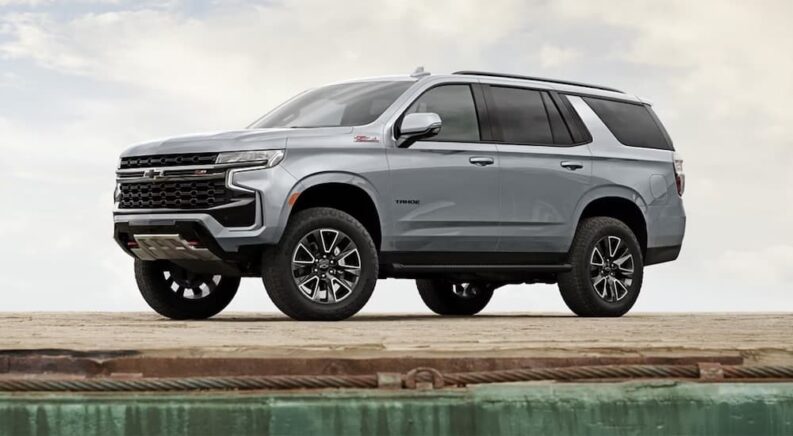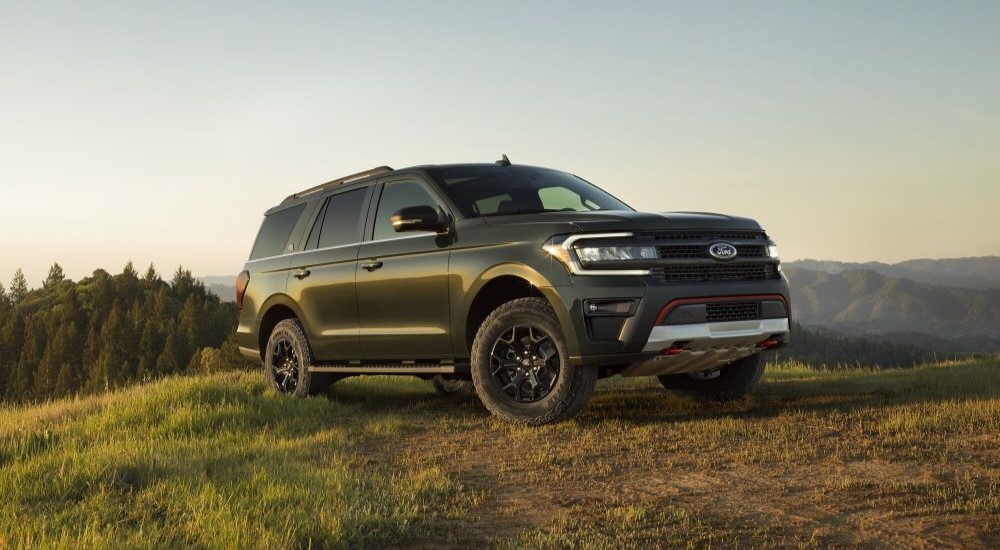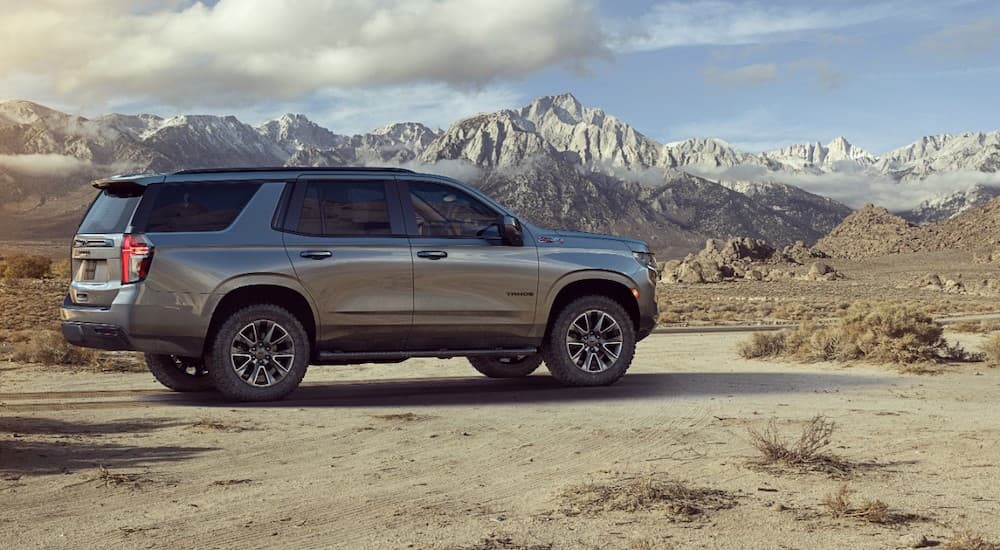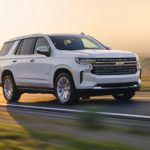Off-road enthusiasts who want the power and ruggedness of a truck and more interior space for people, equipment, and luggage often pick the Tahoe Z71. Originally introduced as a special edition for the 2000 model year, the Tahoe Z71 has become a permanent member of the Chevy Tahoe family. As the Tahoe has evolved, so has the Tahoe Z71, with the fifth generation version introduced in 2021 being Chevy’s pinnacle off-road SUV. A Chevy Tahoe for sale with a Z71 package has the latest off-road performance components and style to head out for adventure.
However, to no one’s surprise, Ford hasn’t been content to let Chevy sit atop the off-road SUV throne. The Ford Expedition Timberline is the latest challenger to the Tahoe Z71—and its introduction in 2022 has driven both manufacturers to stay on top of their game. Has the Expedition Timberline run down the Tahoe Z71 in the charge up the mountaintop? We’re here to look at what they offer in terms of off-roading and overall performance to see which currently reigns supreme in the latest Chevy vs Ford battle.
The Old Guard vs The New Kid
First, it’s time for a quick recap of how this matchup came to pass. Among the major vehicle manufacturers, the Z71 is arguably the off-roading OG. It originated in 1988 with the less-cooly-named Off-Road Chassis Package that Chevy decided to offer on its revamped pickup trucks. This package had an internal Regular Production Option (RPO) code of Z71. Although Chevy didn’t use the code publicly at first, buyers quickly caught on. Seeing a marketing opportunity, Chevy began adding Z71 stickers to its off-road trucks beginning in 1992 and soon began offering the package on the Chevy Blazer SUV.
The Chevy Tahoe replaced the Blazer in 1995 but didn’t get a Z71 option until five years later. Still, it marked an important occasion, as the Tahoe was the first vehicle where the Z71 was an official trim level rather than simply an optional package. Since then, the Z71’s use in the Chevy lineup has continued to expand, with the Silverado, Colorado, Suburban, and Traverse joining the Tahoe.
By comparison, while the Ford Expedition has been around since 1997, the Timberline is an off-roading baby. The Expedition was designed from the get-go as an off-roading vehicle—the second-gen Expedition was the first full-size SUV to have a four-wheel independent suspension, which was based on the suspensions used for desert racing. As such, Ford may simply have not seen the need to offer an off-road edition of a vehicle already intended for serious off-roaders.
However, with the continuing advancements of the Tahoe Z71 and Jeep Wagoneer—plus the Expedition shifting its focus to family-friendly transportation—Ford eventually reversed course. When the fourth-generation Ford Expedition came out in 2018, it offered the FX4 off-road package, which included components like an electronic limited-slip differential and specially tuned shocks. Then, for 2022, Ford announced the Expedition Timberline, joining the Explorer Timberline introduced the year before. Touted as the best off-roading Expedition ever produced, it now takes on the Tahoe Z71 for the trail-ready crown.
Unpacking the Tahoe Z71 and Expedition Timberline
How do the Z71 and Timberline trims make these full-size SUVs better for off-roading—and which is better for going where you want to go? Let’s look closer at the things that matter to off-roaders.
Suspension and Chassis
The Tahoe Z71 and Expedition Timberline both have impressive engines, transmissions, and towing capacities—but the biggest thing that matters for off-road vehicles is the underpinnings. If they don’t have the right suspension, tires, and other components, it won’t matter how much power you’re toting, because you won’t be able to get it to the trail.
Chevy has prepared the Tahoe Z71 to handle a variety of terrains and the main roads, too. It comes standard with coilover front shocks, a multi-link rear suspension, a protective front skid plate, and front recovery hooks. The 33-inch all-terrain tires and 20-inch machined aluminum wheels provide excellent traction, especially when paired with the StabiliTrak traction and stability system. By adding the optional adaptive air suspension—the only one of its kind among full-size SUVs—the vehicle will automatically adjust ride height independently at each corner based on conditions for more clearance or better aerodynamics.
The Expedition Timberline has some of the same features, including premium shocks, multi-link rear suspension, and stability control. However, although its all-terrain tires are roughly the same height, the standard wheels are two inches smaller. This means the sidewall is significantly taller, which provides more wheel protection when off-roading at the expense of on-road handling. Though the Expedition Timberline has more ground clearance than the Tahoe Z71, you can’t auto-lower the ride height, so the overall ride may feel less balanced.
Both vehicles have a limited-slip rear differential, but while the Expedition Timberline only has an electronic option, the Tahoe Z71 has a choice of electronic or mechanical setups. As such, you can choose between the precision of electronics or the old-school freedom of mechanical components. Each also has a transfer case that can automatically switch you between two-wheel and four-wheel drive modes for the best ride quality—or you can lock it into one mode if you prefer.
Interior and Cargo
One of the biggest reasons to get a full-size SUV instead of a truck for off-roading is the interior setup. If you don’t want your equipment and supplies to get drenched by a downpour or covered in mud, a covered SUV cargo bay will protect them. Big SUVs also allow you to bring more people (or more things) for extended outings.
If you want maximum space, the Tahoe Z71 is your ride. It has a standard cargo capacity of 25.5 cu.ft. when all three rows of seats are up, and by folding down seats, you can increase the capacity to a whopping 122.9 cu.ft. This is almost 20% more than the 104.6 cu.ft. available in the Expedition Timberline. The Chevy Tahoe also has more front headroom and shoulder room plus more front and rear legroom, though the Expedition Timberline does have a bit more rear headroom.
The Tahoe Z71 also has some of the most useful driver assistance technology and components to help with off-roading. Trailer sway control is included, and you can add an advanced trailer package with 13 available camera views if you want more guidance when hauling campers or off-road vehicles. If you are interested in towing, you will probably also appreciate the Duramax turbo-diesel engine available in the Tahoe, which lets you haul long distances without stopping to refuel as often.
The Tahoe Z71 Remains at the Top
Does the Ford Expedition Timberline have some things going for it? No doubt. The 440 hp EcoBoost turbocharged engine will give you plenty of power under your right foot, and the high ground clearance is ideal for rock crawling or general overlanding. In terms of overall off-road and on-road performance, though, the Chevy Tahoe Z71 still stands on top.
The four-corner adaptive suspension gives you the best possible ride no matter the terrain or weather—and you don’t even have to do anything. Some of the other things we love are the added cargo and passenger space, the better-handling tire and wheel combination, and the advanced trailering features. It’s enough to keep the Tahoe Z71 the sultan of full-size off-road SUVs and continue fending off the challenge of the Expedition Timberline.






